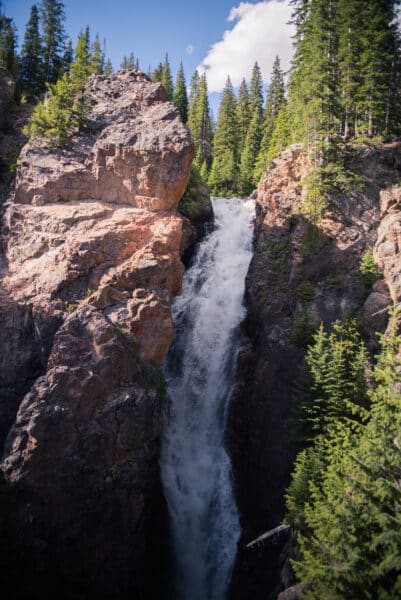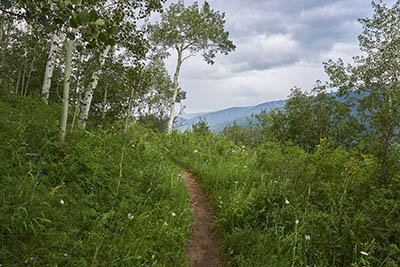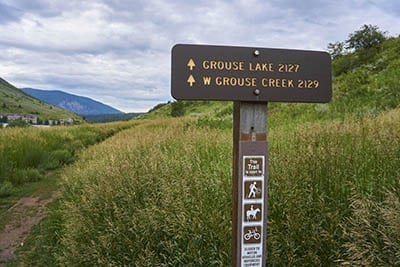
At-A-Glance

Season:
Winter
Months:
Nov - April
Vail Cross-Country Skiing
In winter, the Vail Golf Club transforms into the Vail Nordic Center, with seemingly endless acres of groomed tracks and trails. Here, cross-country skiers of all stripes can glide through the snow with the white-capped Rockies as the backdrop.
WHAT IS NORDIC SKIING?
You know those people carving down a steep mountainside on skis? Nordic skiing is not that. That would be alpine skiing. Nordic skiing, also known as cross-country skiing, typically takes place on flatter terrain at a slower pace — but the big difference is in the footwear.
Nordic skiing is any type of skiing where the toe of the boot is attached to the ski, but the heel is not. In alpine skiing, both the heel and toe of the boot are attached — making it more stable for zooming down slopes — but awkward for moving on flat surfaces or inclines.
If you’re new to the sport, the Vail Nordic Center has you covered with equipment rentals, lessons and cozy clothing. It’s the best spot to immerse yourself in the world of cross-country skiing in Vail.

VAIL NORDIC CENTER TRAILS
Once you arrive at Vail Nordic Center, it’s time to uncover miles of quiet forest loops, rolling meadows and towering-mountain outlooks. Here are some paths worth exploring:
- The Teaching Loop: Appropriately named, this short loop helps to get the skis under your feet, understand the fundamentals and ensure the equipment feels just right.
- Sunburst Loop: Just off the Teaching Loop is the Sunburst Loop, with a very moderate hill that can be accessed in either direction. This, combined with the Teaching Loop, is a nice half-mile of track.
- Stable Flats: Once you feel comfortable, venture out to Stable Flats, which are just what they sound like — flat track over 2.5 kilometers. It crosses snowshoe and fat-tire-biking paths, so be sure to stay on the cross-country cut track as you make your way east along the valley floor.
- Thirteen to Training Loop to Chicken Ridge to Gore Creek Flats: These trails follow the path along Gore Creek and over meadows for about a mile each way. The ascents and descents are a little steeper, but there’s always the option to “duck walk” up or even take your skis off. This section of the trails tends to be less crowded and offers the solitude of nature and soaring views of the Gore Range.
- Training Loop to Fricker’s Freeway: After a short downhill, this trail meets back up with Stable Flats, leading you back at the Club House for a nearly 5-mile total loop.
- Sunburst to Soccer Field Connector to Ptarmigan to Ben Here to Soccer Field Loop to The Plunge and back to Sunburst: This entire loop is about 1.5 miles and worth exploring but be prepared for road crossings and steep hills up and down.
TYPES OF NORDIC SKIING
Cross-country skiing is the most popular form of Nordic skiing in Colorado — but it’s not the only one. You have three types of Nordic skiing to choose from:
- Cross-country skiing: Incredibly easy to learn, cross-country skiing uses lightweight, skinny skis and poles to glide through groomed tracks in the snow.
- Telemark skiing: Thicker and heavier skis are needed for this off-trail version of Nordic skiing.
- Alpine touring: This version uses thicker, heavier skis that let you either bind just your toe or both your heel and toe. Bind both heel and toe for heading down steep hills. Unbind the heel for trekking over flatter or uphill terrain.
A WINTER WORKOUT
No matter what type of Nordic skiing you try, you’ll be amazed at the number of calories burned by this winter activity. The faster you go, the bigger the burn. Someone who weighs 150 pounds can burn:
- 400 to 500 calories per hour at speeds of 2.5 mph
- 550 to 600 calories per hour at speeds of 4 to 5 mph
- 600 to 650 calories per hour at speeds of 5 to 8 mph
Not only is Nordic skiing one of the best calorie-burning activities on the planet, but it also gives you a full-body workout. In fact, cross-country skiers are hailed as the world’s fittest athletes when it comes to endurance. So much so, they’ve been called the “the elite endurance animals of winter sports.”
WHAT TO WEAR NORDIC SKIING IN COLORADO
One of the best parts of trying any new activity? Buying a snazzy outfit to go along with it. When it comes to cross-country skiing, your best bet is to dress in three fashionable layers.
- Base layer: Worn closest to your skin, the base layer’s job is to wick moisture and sweat away from your body. Opt for comfy, lightweight items made of synthetic or wool fabric. Polyester and merino wool are good picks.
- Middle layer: The job of this layer is to keep you warm and cozy without weighing you down. Lightweight puffy jackets are a good choice, as is fleece.
- Outer layer: This layer exists to keep out the elements. Choose a jacket and snow pants that are windproof, water resistant and breathable.
Look for clothing features that make it easy to adjust your temperature, like extra zippers and vents. Expect to get a bit warm while you’re on the move. Fashionable and functional accessories are also on the list of must-haves. These include:
- Hat or headband: To keep your ears toasty
- Gaiter or balaclava: For neck and head protection
- Socks: A base layer of liner socks topped with thin wool or synthetic socks
- Gloves: Layer glove liners and waterproof outer gloves so you can add or shed them as needed
- Daypack or ski pack: To bring along anything that doesn’t fit in your pockets
Getting your Nordic-ski gear in Vail is easy. Plenty of local shops have everything you need for a fun-filled day on frosty trails. Even more convenient, you can take advantage of the rental equipment at the Vail Nordic Center. The folks at the center will hook you up with skis, boots, poles and anything else you may need based on the type of Nordic skiing you plan to tackle. You can expect to be outfitted with:
- Skis with bindings
- Ski poles
- Ski boots
Don’t forget the sun protection! The snow acts as one big mirror, reflecting the rays on bluebird days and cloudy days. Plus, Vail’s high elevation means you’re even closer to the sun. Consider clothing with built-in protection. Also bring along:
- Sunglasses
- Sunscreen
- Protective lip balm
WHERE TO SKI: GROOMED TRACK VS. OFF TRAIL
Now the big, exciting question: Where should you ski? Choices include groomed tracks, off-trail areas or the more rugged backcountry.
Groomed Tracks
For first-time Nordic skiers, groomed tracks are the way to go. These Nordic trails consist of preset tracks made in the snow. Just put your skis in the tracks and voila, you can glide forward with grace and ease (especially after a lesson or two). The center has a Nordic trail system featuring more than 10 miles of smooth, groomed track. Keep it pleasurable for all by keeping a few tips in mind:
- If you need to stop, step aside off the ski trail so you don’t block anyone coming up behind you.
- Look behind you before you step aside so you don’t step right into someone else’s path.
- Stay on the tracks.
- Don’t wreck the tracks.

Off-Track Trails
Once you’re feeling more confident, you can try your hand (or foot) at Nordic skiing on the open snow. While you won’t have the tracks to help you out, you will have the option of going left, right, back and forth. The terrain is tougher to ski without tracks, but the sparkly snowcapped scenery makes it worth it. The Vail Nordic Center has a 6-mile trail system designed for off-track skiing and snowshoeing.
The Backcountry Near Vail
Backcountry skiing involves heading far off the beaten path. Skiing in this area is best reserved for people who are highly skilled, highly prepared and competent with a compass. Learn more about backcountry safety.
BASIC TECHNIQUES
You got your new clothes, all the right gear and the perfect place to embark on your adventure. Now what? Your next move depends on the style of cross-country skiing you’re trying. If you recall, Nordic skiing comes in three varieties:
- Cross-country skiing
- Telemark skiing
- Alpine touring
CROSS-COUNTRY SKIING STYLES
You decided to try cross-country skiing. Now it’s time to decide what style of cross-country skiing you want to try:
- Classic skiing: This is the most familiar style of cross-country skiing. It’s also the best pick for beginners. Here you use a striding motion similar to the way you walk or run. Simply stride your legs forward and back – and you’re gliding along the snow.
- Skate skiing: This technique is akin to a speed skater whizzing across the ice. Instead of shuffling forward and back, you push your skis out to the side. The edges of the skis propel you forward – and you’re whooshing along the snow.
Note that skate skiing should be done in skate skiing areas without disrupting the classic skiing tracks. Otherwise, you’ll ruin the tracks, breaking one of the major etiquette rules. Starting with the classic style of cross-country skiing is the best option for first-time Nordic skiers. Another wise choice is opting for lessons so you can hit the snow running (figuratively, of course).
The Vail Nordic Center serves up daily individual and group lessons as well as specialty clinics on technique and tuning for adults and children. This makes it both fun and easy to transform Nordic skiing into a family affair.
Discover More Vail Winter Adventures
Looking for more winter trip inspiration? Check out these resources for your Vail itinerary.













